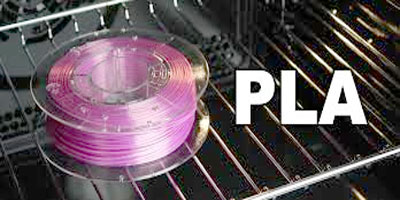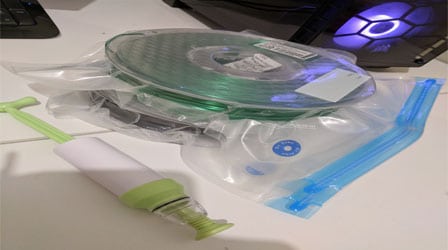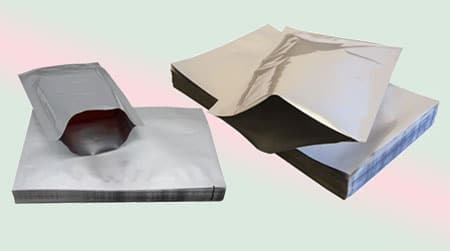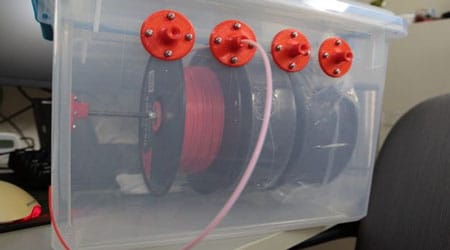If you use FDM 3D printers, you already know that moisture is your biggest enemy. The filaments that you use for FDM printers are extremely moisture hungry. If you keep your filaments on the open air for a day or two, there is a good chance that it is already ruined.

PLA filaments are even more susceptible to moisture damage. Since it has a low melting temperature, it is critical to keep it dry for optimal performance.
Failing to keep your filament dry can cause your prints to come out ruined or, in extreme cases, can clog up the extruder assembly of your printer.
So how do you keep it dry?
Or if it gets damaged, is there any way to fix this? In this article, we will cover all of these issues to help you prepare better and keep your PLA filaments safe.
How to Keep Your PLA Filament Dry for Optimal Printing
The glass transition temperature of the PLA filament is around 70 degrees Celsius. This means, if your filament roll gets close to this temperature, it will start to soften and will get damaged eventually.
So, applying heat directly to dry filament is not the best way to go. Here are a couple of ways to keep your PLA filament dry to get the best performance out of it during printing.
Read our related article on How to Dry Out PETG Filament for common methods and instructions!
1. Store It In Plastic Airtight Bags

There is a saying, “prevention is better than cure,” and it is especially true for PLA filaments. If you can protect your filaments so that it does not get damaged due to moisture, you do not have to dry it at all. And if you exercise a bit of caution, it is not that hard to achieve.
The simplest way to do that is to store your PLA filaments in an airtight plastic bag or container of some sort. You could also throw in a couple of packs of silica gel to absorb any of the moisture that gets trapped inside it. This process is cheap and quite effective at keeping moisture away from it.
The only issue with this process is that it does not offer a permanent solution. An airtight plastic bag does not entirely prevent moisture but rather drastically reduces it.
If you keep your filaments inside the bag for several months, it will start absorbing moisture after a while, even with silica gel inside it.
Besides, storing in plastic bags might reduce moisture damage but opens up the doorway to another big problem, UV degradation.
Since PLA is not as stable as other filaments like PETG or ABS, it is quite susceptible to UV degradation, which is just as bad as moisture damage.
We wrote a guide on How to Store 3D Printer Filament, so be sure to stop by for more information.
2. Use A Mylar Foil Bag

As we said before, using an airtight plastic bag might not be the best choice for long-term storage since it does not protect against moisture indefinitely.
You could use specific boxes designed for filaments, but those containers are quite expensive. A cheaper alternative would be to used vacuum-sealed mylar foil bags.
Mylar foils come with a thin aluminum layer which also has a laminating of polyester resin. As a result, it is extremely reflective, waterproof, and quite durable. This material is almost exclusively used for food packaging as well as a protective cover for decorative items.
The main advantage of this material is that it offers much better moisture resistance compared to plastic bags because of the thin aluminum layer.
As a result, it is perfectly capable of keeping your filament dry for a much longer period. Still, you want to keep a couple of silica packs inside it just to be safe.
In addition, the reflective outer layer of the Mylar foil also protects it against UV degradation, which is one of the main issues with plastic bags.
Read our related article where we share our 3D Filament Dry Box DIY! These homemade boxes will keep your filament moisture-free and save you money in the long run.
3. Dry Your PLA Filaments

If your PLA filaments do get affected by moisture, then the only way forward is to dry it; unless you want to discard it completely. There are a couple of different ways to do that.
The most effective yet expensive way to go is to use a filament dryer. This contraption is designed specifically for this purpose but can cost quite a bit. However, it will get rid of all the moisture from the filaments easily.
All you have to do is put the roll of filament inside it, choose the drying setting, and start it up. After a certain amount of time, you can take out the roll, and it should be free from any trapped moisture. The process is extremely simple and intuitive.
You can also use a food dehydrator if you have one at your home. Although primarily designed to remove moisture from food materials, this contraption works wonders in removing moisture from filament spools.
While we’re on spools… here’s a fun guide on What to Do With Old Filament Spools. Be sure to check it out!
These are also quite affordable, making it a great budget option for dehydrating filaments.
The final way to remove moisture is to use a high-quality oven. Do not trust a simple, budget oven for this type of job.
The oven needs to be extremely accurate and should be able to control the temperatures precisely. Otherwise, you might do more harm than good.
For PLA filaments, you need to keep the temperature in the oven at a range of 40 to 50 degrees Celsius.
If the oven can maintain this temperature with the spool of filaments inside it for four to six hours, then the spool will come out fully dehydrated and ready to use with your printer.
How To Recognize Wet Filament?
As long as you practice proper storage methods, you should never have to worry about wet filaments ruining your prints. However, you need to know the issues that wet filaments can cause to identify these issues properly.
Without understanding how you can recognize a wet filament; you will not be able to troubleshoot an issue with your 3D printers easily. Here are the common issues that you will notice when working with wet filaments.
1. Brittle Filament
A PLA filament is slightly elastic by nature. However, once it absorbs a certain amount of moisture, it starts losing its elasticity. At one point, the filament will become brittle, which can cause it to snap when you use it in the printer. This is a telltale sign that the filament is full of moisture.
Since this is not a reversible process, there is a high chance that you have to dispose of it. So, you want to prevent your filament from becoming brittle as this means you have just wasted your money.
Read our related article on How to Fix Brittle Filament to learn how to prevent and solve brittle filament issues.
2. Swollen Filament
An early sign of moisture damage is swelling of the filament. But it can be difficult to track using your eyes. If you have a digital micrometer, you can easily check if the filament has swollen to see if it is absorbing moisture. So, investing in a digital micrometer if you have a 3D FDM printer is a good idea.
For this to work, you should take an initial measurement when you buy a set of PLA filament. Then before every use, you want to check the diameter and look for any changes. However, if you store your filaments properly, you should not have to worry about swollen filaments at all.
3. Popping Or Hissing Sound In The Extruder
If you cannot identify whether your filament is wet before you put it inside the printer, you can definitely notice it once you put it to use. When the moisture-filled filament reaches your extruder, the heat from the element will convert the moisture in the filament into steam.
Because of this reaction, you will hear popping sounds coming out of the extruder. You can also notice visible steam, which should be a clear indication of the moisture issue.
Read More: Can You 3D Print Food Safe? We explore food-safe 3D prints and 3D-printed food here!
4. Uneven Extrusion Lines
Even if you do not hear any sound or cannot see smokes, you will certainly notice the inconsistencies in the flow of filament. You will see holes in the layer lines, and the end result of your print will not be good. If that happens, you do not want to continue using the filament, as it will negatively affect the durability of your printer.
Read More: How to Waterproof a 3D Print. Follow these tips for watertight projects!
5. Severe Stringing Or Blobbing
With moisture-filled filaments, the nozzle will face a lot of excessive pressure, which can force out molten filament even when it is not supposed to use it. This becomes even more apparent if your design requires the drone to travel without ejecting filament.
Although this can be caused by other factors, it is always worth checking for moisture issues first. In any caser, you should not continue printing if you see such stringing issues with your 3D printer until you identify the cause.
Read our related article on Tough PLA vs PLA to see how PLA and PLA+ compare.
Final Thoughts
The PLA filament is arguably the most popular type of filament used for FDM printing because of its affordability and ease of use. However, improper storage and carelessness can cause severe moisture issues with this filament making it completely unusable.
However, if you practice caution and follow the steps we mentioned in our guide, you should not have to deal with this issue. And even if you do, our tips on how to dry PLA filament should help you get things sorted out quite easily.